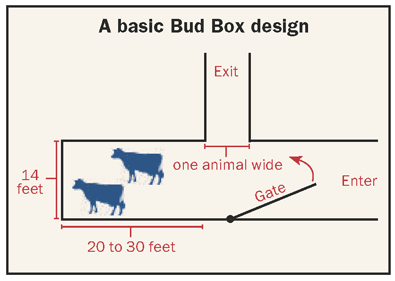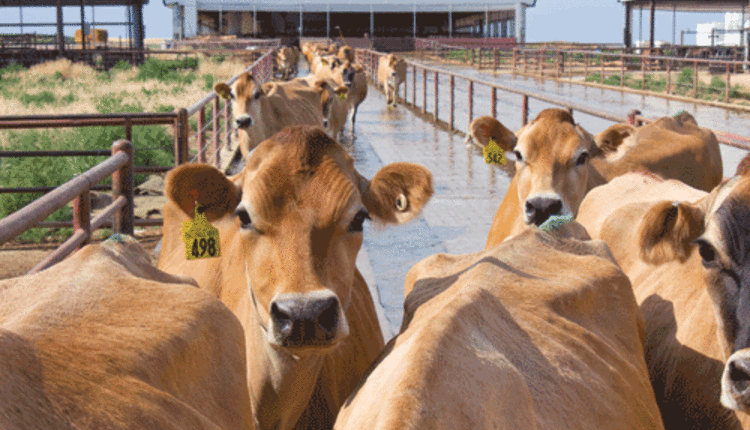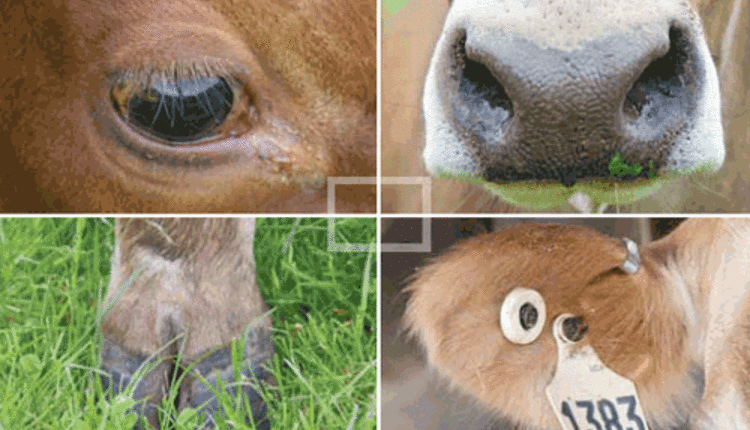Thomas is an author of many livestock books and owns a beef cattle herd with her husband in Salmon, Idaho. She wrote this series with Paul Rapnicki, D.V.M., formerly with the University of Minnesota School of Veterinary Medicine (UMN-SVM) and Don Höglund, D.V.M., currently with the UMN-SVM.
 Think of your dairy operation as a cow handling system that cares for the well-being of the cattle and the people who work on your operation.
Think of your dairy operation as a cow handling system that cares for the well-being of the cattle and the people who work on your operation.
There are two main components in a cattle handling system. First is the design and maintenance of the barn and handling facilities. Second is the stockmanship skills of the people who work on your dairy.
The Bud Box, a very simple facility design, can be incorporated into any operation. When used by properly trained people, the Bud Box concept can greatly assist in the safe and efficient handling of cattle.
Borrow from beef operations
The Bud Box is named after Bud Williams of Independence, Kan. For many years, Bud promoted the concept of using a box-shaped set of gates when loading beef cattle onto trucks or into a processing chute. The simple design of the Bud Box allows a stockperson to take advantage of many of the natural behavioral tendencies of cattle.
The Bud Box is 14 feet wide and 20 to 30 feet long. A gate is closed once all cattle are in the Bud Box. The gate that closes should latch near the exit lane from the Bud Box (see figure). The exit lane should be one animal wide and perpendicular to the "box" area. The dimensions are guidelines but are similar regardless of the size of the cattle or the number of cattle that need to be worked through the Bud Box.
It is recommended to use open (see-through) gating for a Bud Box. The exception is that there may be some benefit to having the gate that closes be a solid panel to help direct the cows' focus to the exit opening. Good stockmanship techniques allow the cattle to easily see our movements. Dairies that use solid panels frequently do so to make up for the poor stockmanship habits of the people who work around the cattle.

The Bud Box facilitates low-stress handling of cattle because it allows us to take advantage of some important tendencies:
1. Cattle tend to follow other cattle.
2. Cattle tend to exit a pen at the same point that they entered.
3. Cattle respond when they can easily see what is pressuring them.
Let us illustrate using the Bud Box by moving a single cow through the system. As the cow is brought into the Bud Box, she will be forced to stop once she reaches the end of the box. At this point, a person enters the Bud Box and closes the gate, standing in front of the exit lane.
When the cow reaches the end of the box, she will want to turn back and leave the box at the same point that she entered. She will be facing the person, but if the person is positioned properly in front of the box exit, the cow can see the exit from the box.
As we have been discussing, you apply pressure to a cow by your position, timing, angle and speed of encroachment toward the cow. You should add pressure by taking some steps toward the cow. As pressure on the cow grows due to this encroachment, she will have a strong tendency to remove this pressure by moving past the person and into the exit from the box.
Once the cow starts toward the box exit, the person should continue to walk past the cow. From this position, the cow can easily keep an eye on you (the pressure) and also see the opening which allows for the release of that pressure.
You can visualize this as the cow moving in an arc around the person and person working inside a circle relative to the cow. Working inside the circle is a good stockmanship technique because it allows the cow to always see your position and to watch your movements. The design of the Bud Box assists us in keeping the cow and the handler in correct position relative to each other and to the exit from the pen.
Groups require same technique
With more than one cow in a Bud Box, the movement and position of the person is the same. Groups provide the additional benefit that cows tend to follow other cows. The key is to pressure properly to get the first cow moving toward the exit.
When she starts to move toward the exit, do not make any movements that stop her from moving forward. Remember, if you walk parallel with a cow, you tend to slow her down, so do not walk with the cow. Stay inside the curve created by the cow's movement toward the exit.
Patience is required to work with cattle using a Bud Box. You must allow a little time for them to understand the process. It is counterproductive to force cows out of a Bud Box. It is safe and efficient to allow them to initiate their own movement out of the box.
Remember that there are two things that prompt cows to move into and out of a Bud Box: technique and stimulus. Proper technique involves your position in the Bud Box. The stimulus is the timing, angle and speed of your movement within the box. The Bud Box design will help guide your position and allow you to precisely control the level of stimulus for movement.
Moving young stock between the ages of 6 months and 2 years is very easy with a Bud Box handling system. Young stock have energy and motion that is easily controlled and guided in such a system. Additionally, young animals are very easy to teach proper behaviors. Consider using a Bud Box system to not only make their handling safe and efficient but to also teach them to respond to movement pressure and become easier to handle as older animals.
Knowing that cattle react to our actions, we can avoid mistakes that create improper responses. If we pay attention to what cattle are telling us, we can use proper position and timing to create proper pressure for desired response. Improving our handling skills will eliminate the negative behavior caused by human inexperience and poor technique. Cows react predictably if we tailor our actions to elicit the proper response.
Each time cattle are worked properly they learn what to do and become easier to work the next time. They learn calm handling if handled calmly. Frequently, we find some older cows in a herd that are difficult to move. We must understand that current behavior is the sum total of a cow's interactions with humans over her lifetime; positive and negative.
Click here to return to the Animal Care E-Sources 120925_604
 Think of your dairy operation as a cow handling system that cares for the well-being of the cattle and the people who work on your operation.
Think of your dairy operation as a cow handling system that cares for the well-being of the cattle and the people who work on your operation.There are two main components in a cattle handling system. First is the design and maintenance of the barn and handling facilities. Second is the stockmanship skills of the people who work on your dairy.
The Bud Box, a very simple facility design, can be incorporated into any operation. When used by properly trained people, the Bud Box concept can greatly assist in the safe and efficient handling of cattle.
Borrow from beef operations
The Bud Box is named after Bud Williams of Independence, Kan. For many years, Bud promoted the concept of using a box-shaped set of gates when loading beef cattle onto trucks or into a processing chute. The simple design of the Bud Box allows a stockperson to take advantage of many of the natural behavioral tendencies of cattle.
The Bud Box is 14 feet wide and 20 to 30 feet long. A gate is closed once all cattle are in the Bud Box. The gate that closes should latch near the exit lane from the Bud Box (see figure). The exit lane should be one animal wide and perpendicular to the "box" area. The dimensions are guidelines but are similar regardless of the size of the cattle or the number of cattle that need to be worked through the Bud Box.
It is recommended to use open (see-through) gating for a Bud Box. The exception is that there may be some benefit to having the gate that closes be a solid panel to help direct the cows' focus to the exit opening. Good stockmanship techniques allow the cattle to easily see our movements. Dairies that use solid panels frequently do so to make up for the poor stockmanship habits of the people who work around the cattle.

The Bud Box facilitates low-stress handling of cattle because it allows us to take advantage of some important tendencies:
1. Cattle tend to follow other cattle.
2. Cattle tend to exit a pen at the same point that they entered.
3. Cattle respond when they can easily see what is pressuring them.
Let us illustrate using the Bud Box by moving a single cow through the system. As the cow is brought into the Bud Box, she will be forced to stop once she reaches the end of the box. At this point, a person enters the Bud Box and closes the gate, standing in front of the exit lane.
When the cow reaches the end of the box, she will want to turn back and leave the box at the same point that she entered. She will be facing the person, but if the person is positioned properly in front of the box exit, the cow can see the exit from the box.
As we have been discussing, you apply pressure to a cow by your position, timing, angle and speed of encroachment toward the cow. You should add pressure by taking some steps toward the cow. As pressure on the cow grows due to this encroachment, she will have a strong tendency to remove this pressure by moving past the person and into the exit from the box.
Once the cow starts toward the box exit, the person should continue to walk past the cow. From this position, the cow can easily keep an eye on you (the pressure) and also see the opening which allows for the release of that pressure.
You can visualize this as the cow moving in an arc around the person and person working inside a circle relative to the cow. Working inside the circle is a good stockmanship technique because it allows the cow to always see your position and to watch your movements. The design of the Bud Box assists us in keeping the cow and the handler in correct position relative to each other and to the exit from the pen.
Groups require same technique
With more than one cow in a Bud Box, the movement and position of the person is the same. Groups provide the additional benefit that cows tend to follow other cows. The key is to pressure properly to get the first cow moving toward the exit.
When she starts to move toward the exit, do not make any movements that stop her from moving forward. Remember, if you walk parallel with a cow, you tend to slow her down, so do not walk with the cow. Stay inside the curve created by the cow's movement toward the exit.
Patience is required to work with cattle using a Bud Box. You must allow a little time for them to understand the process. It is counterproductive to force cows out of a Bud Box. It is safe and efficient to allow them to initiate their own movement out of the box.
Remember that there are two things that prompt cows to move into and out of a Bud Box: technique and stimulus. Proper technique involves your position in the Bud Box. The stimulus is the timing, angle and speed of your movement within the box. The Bud Box design will help guide your position and allow you to precisely control the level of stimulus for movement.
Moving young stock between the ages of 6 months and 2 years is very easy with a Bud Box handling system. Young stock have energy and motion that is easily controlled and guided in such a system. Additionally, young animals are very easy to teach proper behaviors. Consider using a Bud Box system to not only make their handling safe and efficient but to also teach them to respond to movement pressure and become easier to handle as older animals.
Knowing that cattle react to our actions, we can avoid mistakes that create improper responses. If we pay attention to what cattle are telling us, we can use proper position and timing to create proper pressure for desired response. Improving our handling skills will eliminate the negative behavior caused by human inexperience and poor technique. Cows react predictably if we tailor our actions to elicit the proper response.
Each time cattle are worked properly they learn what to do and become easier to work the next time. They learn calm handling if handled calmly. Frequently, we find some older cows in a herd that are difficult to move. We must understand that current behavior is the sum total of a cow's interactions with humans over her lifetime; positive and negative.









